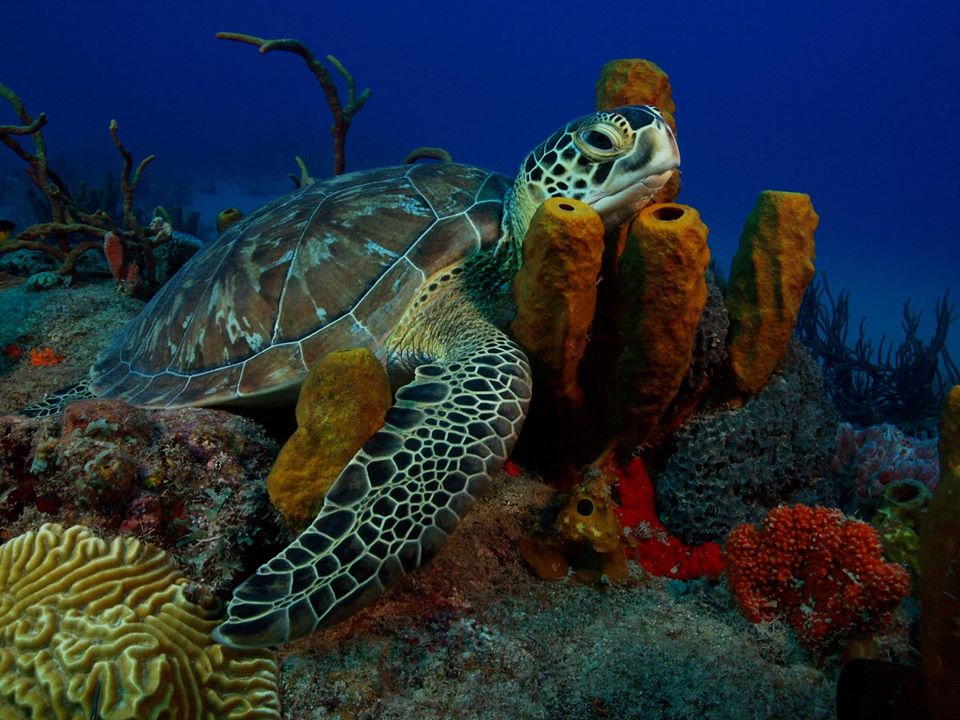Turtle nesting season has started globally, and quiet, empty beaches are perfect for nesting and emerging turtles. The lack of bright and confusing lights from hotels helps mother turtles find suitable nesting sites (remember how hard it is to see the road when there are oncoming bright lights?) and baby turtles find the sea as the sun or moon glare off the sea shows them the way. Turtle lovers are excited about the possible growth in turtle populations as most sea turtles are endangered. Any success is significant as several threats have been reducing their numbers annually: by-catch or targeted fishing or egg-hunting, pollution both at sea and on the beaches, coastal development (populated or over-lit beaches) and climate change (warmer temperatures in the nest are causing all the hatchlings to develop into females).
Since 2002, STENAPA has been monitoring the sea turtles that visit the shores of St Eustatius and the surrounding Marine Park. Nightly patrols help us spot the tracks of hawksbill, green, and leatherback turtles (although hawksbills will challenge rocky shores to find their nests). Information in-line with WIDECAST protocol is taken and the nest hidden to avoid being tampered with. 40 to 60 days later, depending on the species, when the hatchlings emerge, additional data is collected. Over time, the data becomes a story and it tells us the trend in reproductive success, likely genders and so on and so on. Bi-annual in-water turtle surveys (via scuba diving) provides us with information on the population of juvenile and adult turtles in their habitat. Those are the ones who remain for a time in Statia’s waters to forage (eat).
Protecting turtle nesting beaches has also been an ongoing activity over the years, as garbage on the beaches is removed so they do not hinder either the mother or the hatchlings on their journey, and to prevent them from washing out to sea and causing even more problems. Sargassum has been a growing threat to nesting beaches globally. On Statia, the Reforestation Project and Made in Statia Agriculture Centre removes as much of the sargassum as possible and uses it as fertilizer and mulch. We also aid injured turtles, for example, if they are caught in fishing nets or by a hook. Swells, storm surges, cliff-falls, and heavy rainfall can alter the shape and extent of turtle beaches, subsequently endangering established nests. When possible, these endangered nests are safely moved to a secure location. Beach mapping is also done several times a year to keep track of and further understand how the beaches change over time. This helps us predict possible nesting areas and determine which locations are indeed safe.
Involving the community is crucial in protecting the endangered sea turtles as we co-exist on Statia and around the world. Understanding how we impact the populations allows us to mitigate our actions to produce a win-win scenario for humans and turtles. An upcoming campaign aims to do just that. STENAPA sea turtle conservation program has already started with the nightly patrols as we expect turtle tracks any day now. We take this opportunity to thank WIDECAST and Diergaarde Blijdorp for funding and otherwise assisting our turtle program in the past. You can help donate as well by voting for St Eustatius National Parks Foundation to receive a well-needed grant to continue protecting the sea turtles that visit our shores from Turtle Island Restoration Network and SEE Turtles. You can vote by following this link https://act.seaturtles.org/page/17831/data/1. Our ability to protect and increase the population of these endangered marine creatures and our influence on the community will be greatly improved with your donation of a single vote and multiple shares.










